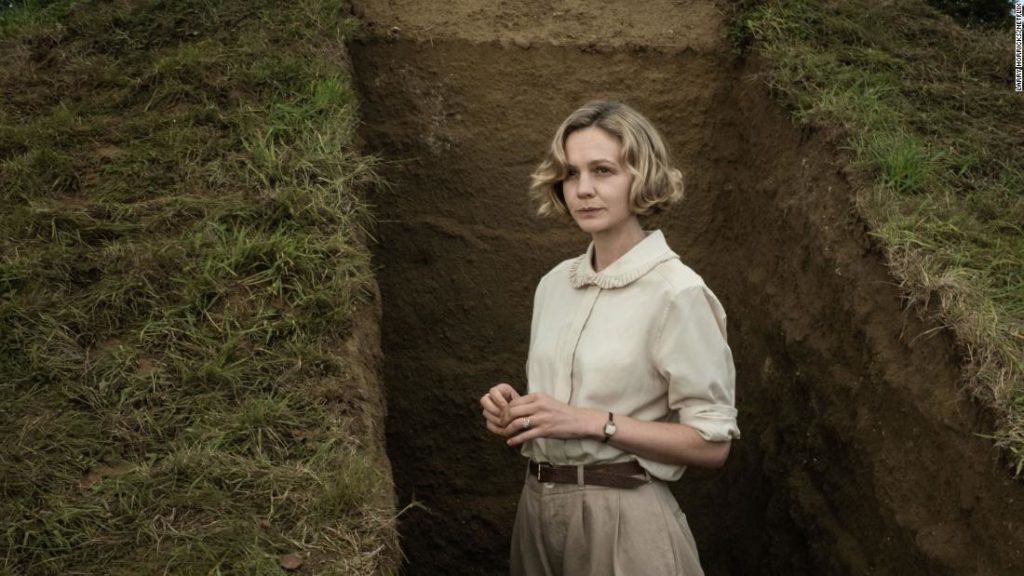Keeping you in the know, Culture Queue is an ongoing series of recommendations for timely books to read, films to watch and podcasts and music to listen to.
If you are endlessly fascinated by these discoveries, Netflix’s new movie “The Dig,” a historical drama starring Carey Mulligan and Ralph Fiennes, should pique your interest.
Based on a true story, “The Dig” retells the story of how a widow and a self-taught archaeologist unearthed an Anglo-Saxon burial ship on a private plot of land in Suffolk, UK, in 1939. The incredible find, which occurred as the specter of World War II loomed over Europe, became one of country’s most important treasures and helped dispel the notion that the British Isles were culturally and economically siloed during the Dark Ages.

Ralph Fiennes as Basil Brown, the self-taught archaelogist who uncovered Britain’s greatest treasure. Credit: Larry Horricks/Netflix
“The film is about time and the fragility of our existence,” said screenwriter Moira Buffini, who adapted the script from John Preston’s book of the same name, in a video interview. “It’s about the brevity of life and what endures — what we leave behind us.”
In the movie, Mulligan plays Edith Pretty, a landowner and mother whose husband has died from cancer. Though part of her life has been taken from her and returned to the ground, the earth gives her something in return.

Wide shots in “The Dig” show a recreation of the site where an 89-foot-long burial ship left an imprint underground. Credit: Larry Horricks/Netflix
Pretty has a hunch about the two large mounds on her land, which is rumored to be a Viking burial site. After she hires Basil Brown, played by Fiennes, to assess and excavate the site, they discover the remains of an 89-foot ship from the 7th century.
“We’re digging down to meet the dead,” Pretty tells Brown in one scene.
Enduring impressions
As the movie recounts, the wooden boat buried at Sutton Hoo had rotted away entirely, though it left a well-preserved imprint in the dirt, like the fossil of a great beast. Inside was a chamber filled with hundreds of valuable artifacts, including an ornate iron helmet, an intricate golden belt buckle and lavish goods from the Byzantine Empire and Middle East, shining a light on the trade and cultural exchange that took place.

A photograph of the real Sutton Hoo location in Suffolk, taken in 1939 upon its discovery. Credit: ANL/Shutterstock
The vessel had seemingly been used for a ship burial, whereby large boats were used as tombs for important figures. But there was no trace of the man, presumed to be Anglo-Saxon royalty, who had been buried with the ship.
“I read the coroner’s report on the king,” said Buffini. “They found nothing: not a tooth, not a hair, nothing of his body. Everything had turned into dust, sand and earth. And yet, you get a feeling of … the whole society of Europe from what’s buried in that boat with him.”

The most famous treasure of the cache is this full-faced iron helmet. Edith Pretty donated all of the artifacts to the British Museum. Credit: Georgie Gillard/ANL/Shutterstock
Though the ship’s remains are a ghostly presence in “The Dig,” the movie focuses on the human stories behind its discovery. Each character grapples with the things they will leave behind, from their physical possessions to their wider legacies.
“The Dig” is available to stream on Netflix.
Add to queue: Unearthing rare discoveries
The Netflix movie is based on this 2007 novel, which recreates the summer following the discovery of the Sutton Hoo treasures from the perspective of three people at the heart of the find.
In 2019, Egyptian archaeologists discovered a massive cache of mummified animals, including cats and snakes, in the Saqqara necropolis outside Cairo. This documentary follows a team of experts as they explore the tomb, which had gone untouched for over 4,000 years.

A still image from documentary “Secrets of the Saqqara Tomb.” Credit: Netflix
Set in a mysterious world of endless rooms and hallways filled with mutable ocean tides, the novel’s protagonist, Piranesi, explores his alternate reality through the thousands of enigmatic statues lining its corridors and the strange ephemera left behind by unknown visitors.
Over the course of 20 seasons, the archaeologists on British television’s “Time Team” encountered their fair share of Saxon burial grounds. In this episode from Season 11, the team investigates what might be a 5th-century cemetery hidden beneath a field.
You may also like
-
Afghanistan: Civilian casualties hit record high amid US withdrawal, UN says
-
How Taiwan is trying to defend against a cyber ‘World War III’
-
Pandemic travel news this week: Quarantine escapes and airplane disguises
-
Why would anyone trust Brexit Britain again?
-
Black fungus: A second crisis is killing survivors of India’s worst Covid wave

